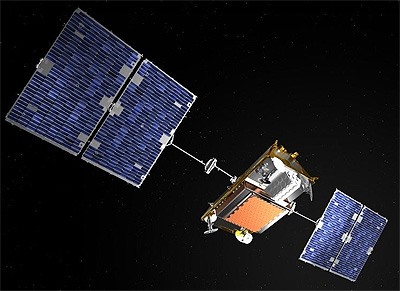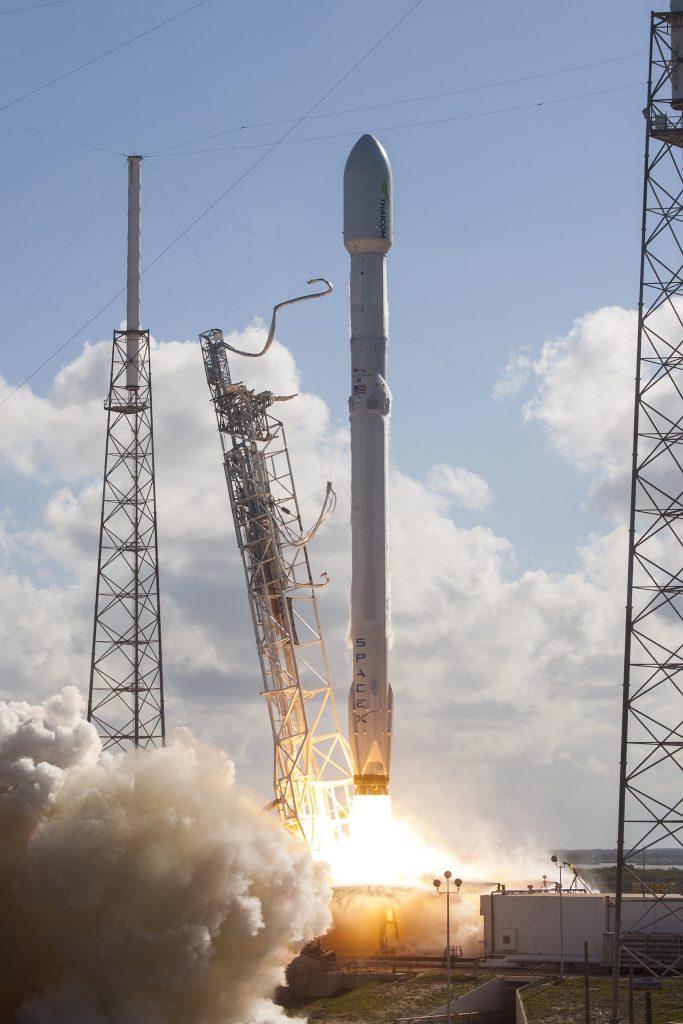
SpaceX is targeting launch of Iridium-6/GRACE-FO on Tuesday, May 22 from Space Launch Complex 4E (SLC-4E) at Vandenberg Air Force Base, California. The instantaneous launch opportunity is at 12:47:58 p.m. PDT, or 19:47:58 UTC. The GRACE-FO satellites will be deployed approximately eleven minutes and thirty seconds after launch, followed by the deployment of five Iridium® NEXT satellites beginning about an hour after launch.
A backup instantaneous launch opportunity is available on Wednesday, May 23 at 12:42 p.m. PDT, or 19:42 UTC. Falcon 9’s first stage for the Iridium-6/GRACE-FO mission previously supported the Zuma mission from Space Launch Complex 40 (SLC-40) at Cape Canaveral Air Force Station in January 2018. SpaceX will not attempt to recover Falcon 9’s first stage after launch.
 |
|
Launch date:
|
May 22, 2018
Instantaneous Launch Window:
|
12:47:58 p.m. PDT/19:47:58 UTC
Backup Launch Window:
|
Wednesday, May 23 (12:42 p.m. PDT/19:42 UTC)
Launch site:
|
SLC-4E Vandenberg Air Force Base, California, USA
{colsp=2}
[highlight]L[eventtimer]2018-05-22 19:47:58;%c%%ddd%/%hh%:%mm%:%ss%[/eventtimer][/highlight]
Mission Patch

Launch coverage:
Payloads:
GRACE-FO
A trove of videos...
[ame="https://www.youtube.com/watch?v=TXu-xS4daoE"]Sneak Peek of NASA's GRACE Twins (media briefing) - YouTube[/ame]
The GRACE-FO (a.k.a. GFO) mission is heavily focused on maintaining data continuity from GRACE and minimizing any data gap after GRACE. Since 2009, the GRACE Follow-On mission is under definition/negotiation by the US-German GRACE consortium (NASA/JPL, CSR/UTexas, DLR, GFZ Helmholtz Center Potsdam).
The GRACE-FO project will be executed in the US under the direction of the NASA Earth Science Division (ESD) within the NASA Science Mission Directorate (SMD) and the Earth Systematic Missions Program Office at GSFC (Goddard Space Flight Center). JPL (Jet Propulsion Laboratory) is assigned responsibility for the GRACE-FO project.
The GRACE-FO mission has significant German participation managed by the German Research Center for Geosciences (GFZ). Funding of the German contributions is jointly secured by the Federal Ministry of Education and Research (BMBF), the Federal Ministry for Economic Affairs and Energy (BMWi), the Helmholtz Association (HGF), the German Aerospace Center (DLR) (LRI in kind contributions) and the German Research Center for Geosciences). The GRACE-FO mission will be operated by DLR/GSOC.
In the fall of 2012, after more than 10 years of very successful operation in orbit, the US-German GRACE-1 mission has demonstrated in a very impressive way its outstanding capability to monitor mass motions in the Earth system with unprecedented accuracy and temporal resolution. These results have stimulated many novel research activities in hydrology, oceanography, glaciology, geophysics and geodesy, which also indicate that long-term monitoring of such mass motions, possibly with improved spatial and temporal resolution, is a must for further understanding of various phenomena.
GRACE-1 gave many breakthroughs in the understanding of:
- Changes in the terrestrial water cycle
- melting and growing of glaciers and ice sheets
- sea level rise and its causes (ice melt, thermal expansion)
- solid Earth (past glaciation, large Earthquakes).
GRACE-FO mission objectives:
• The primary objective is to continue the high-resolution monthly global models of Earth's gravity field of the GRACE-1 mission for an expected length of 5 years.
• The secondary objectives are:
- to demonstrate the effectiveness of a LRI (Laser Ranging Interferometer) in improving the low-low SST (Satellite-to-Satellite Tracking) measurement performance.
- to continue measurements of GRACE radio occultations for operational provision of e.g. vertical temperature/humidity profiles to weather services.
Specifications
Type / Application:|
- Earth Science
- Gravity Field Mapping
Operator:|
- NASA
- GFZ
Contractors:|
- EADS Astrium → Airbus Defence and Space
Equipment:|
- GPS receiver
- Microwave ranging system
- Laser ranging system
Configuration:|
Power:|
- Solar cells
- Batteries
Lifetime:|
- 5 years
Mass:|
- 580 kg
Orbit:|
- 500 km SSO
EOPortal has a very detailed explanation of the payloads and instruments on board GRACE-FO, kindly visit here for more info.
Iridium-6 (Iridium-NEXT 147, 152, 161, 162)
Iridium Communications Inc. announced in June 2010 its comprehensive plan for funding, building and deploying its next-generation satellite constellation, Iridium NEXT to replace the original Iridium constellation. Specifically, the Company announced the execution of a fixed price contract with Thales Alenia Space for the design and construction of satellites for the Iridium NEXT constellation.
Iridium's fixed price contract with Thales Alenia Space provides for the construction of the originally planned 72 operational satellites and in-orbit spares, plus an additional nine ground spares, which provide greater risk mitigation with respect to the new constellation. As a result of the expanded scope of the project, the total cost of Iridium NEXT, including all costs associated with development, manufacture and launch of the constellation, is now anticipated to be approximately $2.9 billion. In addition, Iridium has entered into an Authorization to Proceed (ATP), which allows Thales Alenia Space to commence work immediately on the development of satellites prior to completion of the financing, with the plan to commence the launch of the first satellites during the first quarter of 2015.
Each spacecraft employs an L-band phased array antenna for generation of the 48-beam, 4,700 km diameter cellular pattern on the Earth’s surface for communication with subscribers/users. Ka-band links are also provided for communications with ground-based gateways and for crosslinks with adjacent spacecraft in orbit. The cross-linked 66 satellite constellation forms a global network in space allowing communications from a ground or airborne user from any location on Earth to virtually anywhere else on Earth.

Orbital Sciences Corporation performs assembly, integration and test of the 81 satellites including primary and hosted payloads, shipment and launch integration services at their Gilbert, Arizona, facility.
Secondary Payloads (on board Iridium-NEXT)
Each Iridium-NEXT satellites can provide an opportunity to fly an 50 kg secondary sensor payload. 50 W average power is available for the payload. Data delivery and access to hosted payload will be performed trough the Iridium infrastructure or private gateways.
Aireon LLC, a joint venture with between Iridium and Canada’s air traffic agency NAV CANADA with support from the US Federal Aviation Administration (FAA) and suppliers Harris Corporation and ITT Exelis, will use space-qualified Automatic Dependent Surveillance-Broadcast (ADS-B) receivers built into each of the 81 satellites in Iridium NEXT to provide fully global and continuous space-based monitoring and control of aircraft, even over oceans and remote regions where it is not currently possible. The payloads are based on Harris Corporations's AppStar reconfigurable platform.
58 satellites will carry an AIS (Automatic Identification System) payload for exactEarth to track maritime traffic. These exactView-RT payloads allow for real-time ship tracking data with revisit times of 1 minute. The payloads are based on Harris Corporations's AppStar reconfigurable platform.
Specifications
Type / Application:|
- Communication
- Traffic monitoring
Operator:|
- Iridium Communications Inc.
Contractors:|
- Thales Alenia Space (prime)
- Orbital (integration)
Equipment:|
- L-band payload
- Ka-band cross-links
- Ka-band downlinks
- ADS-B payload
- AIS payload (on 58 satellites)
Configuration:|
Dimensions:|
- 3.1 m x 2.4 m x 1.5 m (Deployed "Wingspan" 9.4 m)
Power:|
- 2 deployable solar arrays
- Batteries
Lifetime:|
- 10 years (design)
- 15 years (planned)
Mass:|
- 860 kg
Orbit:|
- 780 km × 780 km, 86.4° (initial / storage orbit: 667 km × 667 km, 86.4°)
Launch Vehicle:
Falcon 9 FT represents an evolved version of SpaceX’s Falcon 9 v1.1 rocket incorporating a number of performance enhancements to enable the launch vehicle to lift heavy satellites to Geostationary Transfer Orbit while preserving the option of re-using the first stage. Operated by Space Exploration Technologies, the rocket represents the third evolutionary stage of the Falcon 9. The Falcon 9 Full Thrust (FT) vehicle is also known as ‘Falcon 9 Upgrade,’ ‘Enhanced Falcon 9,’ ‘Full Performance Falcon 9’ and ‘Falcon v1.2.’
The Falcon 9 FT launch vehicle is based on the Falcon 9 v1.1 (F9R) which in turn built on the original Falcon 9, retrospectively known as the v1.0 version of the rocket. Falcon 9 v1.0 was inaugurated in 2010 and flew successfully five times until 2013 when it was succeeded by the v1.1 version of the launcher. Falcon 9 v1.1 is retired after 15 missions, one of which was a failure. The v1.1 version itself was subject to a stepwise evolution, notably the implementation of reusability technologies on its first stage. These systems, among other changes, are standard on the Falcon 9 FT that premieres in late 2015 and is likely the final version of Falcon 9 with the maximum possible performance.

The Falcon 9 Full Thrust launch vehicle retains the overall design of the previous Falcon 9 rockets as a two-stage-to-orbit launch vehicle. Its first stage includes all systems necessary for an operational re-use of stages while the second stage is operated as an expendable rocket stage.
Falcon 9 FT stands 70 meters tall, is 3.66 meters in diameter and has a launch mass of 549,054 Kilograms. Both stages use sub-cooled Liquid Oxygen and chilled Rocket Propellant 1 as propellants consumed by Merlin 1D engines, nine of which are installed on the first stage while the second stage hosts a single Merlin 1D engine optimized for operation in vacuum.
SpaceX lists the payload capability of the Falcon 9 FT as 22,800 Kilograms to Low Earth Orbit and 8,300kg to Geostationary Transfer Orbit – these figures are for the fully expendable configuration of the vehicle. Leaving sufficient propellant margin for the return of the first stage to the Autonomous Spaceport Drone Ship for later re-use cuts the payload mass to GTO to around 5,500 Kilograms.
To achieve an operational re-usability of Falcon 9 first stages, all Falcon 9 FT rockets are outfitted with a reaction control system, four grid fins for steering and four deployable landing legs. Dropping the second stage off on its way to orbit, the first stage goes through a series of complex propulsive maneuvers before guiding itself through the atmosphere towards a target landing site for a soft touchdown under the power of one of its Merlin engines to be re-used on a future flight.
Specifications
Height:|
- 70m
Diameter:|
- 3.66m
Launch Mass:|
- 549,054kg
Stages:|
- 2
Boosters:|
- None
Mass to LEO:|
- 22,800 kg
Mass to GTO:|
- 8,300 kg
Mass to Mars:|
- 4,020 kg
Launch Cost:|
- $62M
Weather forecast for Vandenberg AFB
L-1 day launch weather update:
Tomorrow, Tuesday, we have a >90% chance of good weather at the instantaneous launch time of 12:47:58 PDT (19:47:58 UTC). Ground winds are concern.
For backup opportunity Wednesday, there's a 100% chance of good weather.
Links:
- Gunter's Space Page Idirium-NEXT satellite
- Gunter's Space Page GRACE-FO satellite
- SpaceX Falcon 9 Iridium-6/GRACE-FO Mission
- eoPortal Directory GRACE-FO (Gravity Recovery And Climate Experiment - Follow-On) / GFO (GRACE Follow-On)
- Nasaspaceflight.com Forum: SpaceX Falcon 9 : Iridium NEXT Flight 6 with GRACE-FO Mission Thread
- Spaceflight101.com SpaceX Falcon 9 FT (v1.2)
Last edited:
